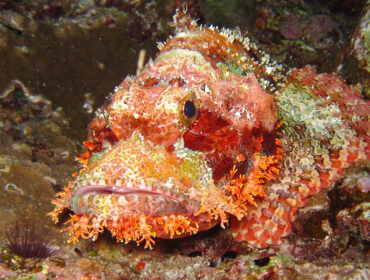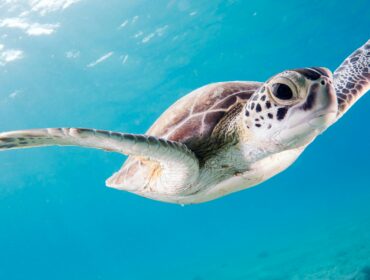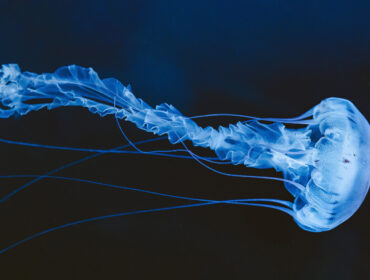Florida is one of the most ecologically rich areas of the US, containing at least 13 unique ecosystems that harbor both endemic and migratory wildlife. The Sunshine State is renown among scuba diving and fishing communities for the beautiful waters surrounding the majority of its landmass and the incredible marine wildlife they harbor, particularly the saltwater species of Florida.
Whether you want to look or lure, Florida is the epicenter of aquatic activity! Let’s check out just 10 intriguing species that make Florida’s reefs and waterways so alluring.
Atlantic Angel Shark
Also known as the sand devil, the Atlantic angel shark is native to the northwestern Atlantic, residing primarily in the Gulf of Mexico and rarely in the Caribbean. Angel sharks are a genus of shark that spend their lives in shallow temperate and tropical seas, close to the substrate where their flattened bodies make for better camouflage. Their extensible jaws are lined with rows of long, sharp teeth like needles, allowing them to catch unsuspecting prey from the water column and substrate.
Atlantic Needlefish
The Atlantic needlefish is an interesting creature because despite being endemic to saltwater, it is often found in estuaries and freshwater bodies as well. This slender endemic saltwater species of Florida feeds primarily on other fish as an adult, but consumes shrimp, amphipods, mysids, and smaller fish as a juvenile. Bottlenose dolphins and juvenile lemon sharks are among their predators.
Banded Butterflyfish
The aptly named banded butterflyfish is a beautiful saltwater species of Florida that can be frequently seen flitting along coral reefs, looking for small invertebrates, crustaceans, eggs, and coral polyps to munch on. At times, the banded butterflyfish will even act as a cleaner fish, nibbling parasites from larger species like surgeonfish and parrotfish.
Longspined Porcupinefish
A favorite among reef lovers, the longspined porcupinefish is a member of the Diodontidae family, making them closely related to other types of puffers in the order Tetraodontiformes. They are typically found in shallow tropical waters, but a few species are known to congregate in larger schools in deeper waters further from shore. The longspined porcupinefish is typical of other puffers in that when it is threatened, it inflates its body with air or water to appear larger and trigger the spines along its body to stand up. These spines often bear tetrodotoxin, a powerful neurotoxin that is 1,200 times more potent than cyanide!
Goldentail Moray
The goldentail moray is another common saltwater species of Florida that is a delight to see poking out of rocky crevices and outcroppings. Reaching a maximum length of 30 inches, this fish is found in both the Atlantic and Gulf of Mexico. It is typically light or dark in background color with yellow spots dotting its length. Its food sources include crustaceans, invertebrates, and mollusks.
Great Hammerhead Shark
The great hammerhead shark is a huge draw for sportfishermen to Florida, where these odd-looking apex predators are prized catch for a determined angler. They are often caught as accidental bycatch in commercial fishing operations, but their intentional catch for the sole purpose of taking their fins is a worldwide issue. Although the great hammerhead shark is listed as globally Endangered on the IUCN Red List, there are no conservation measures in place for this species.
Lined Seahorse
If you didn’t know what to look for, you might miss this saltwater species of Florida right under your nose, due to its incredible camouflage. The lined seahorse grows to a maximum of just 5.9 inches, and their coloration has a wide array of variation. Look for the lined starfish among seagrasses, mangrove roots, sponges, and the underside of floating sargassum, where they can wrap their tails securely around a firmly planted object and suck in prey with its specialized snout.
Longlure Frogfish
Frogfish are some of the reef’s most interesting creatures, but the longlure frogfish is something to see in action. With a body that’s a ringer for many types of reef sponges and a lure (called an illicium) that looks suspiciously like a small fish zipping around the water column, being an ambush feeder isn’t too difficult for the longlure frogfish. When the fish stop biting, it will relocate to start its ruse anew.
Ocean Sunfish
A most unusual saltwater species of Florida, the ocean sunfish can weigh anywhere between 500 and 2,200 lbs, with a wingspan of up to 14 ft and a length of up to 10 ft. Its body is laterally flattened, with large pectoral and anal fins and tiny fan-shaped fins near its eyes. Instead of a caudal, or tail fin, the ocean sunfish’s body ends in a scalloped clavus which it uses as a rudder to move through the water column. They are so named for their frequently observed basking behavior at the surface of the sea, which scientists hypothesize is to “thermally recharge” after long, deep dives.
Queen Triggerfish
Also hilariously known as “old wife,” the queen triggerfish is a common sight on Florida’s reefs and shallow waters. It is typical of a brightly colored tropical fish, displaying blue, green, purple, and yellow with shocking light blue stripes on the fins, tail, and head. Triggerfish have small mouths, but their jaws are incredibly strong with teeth adapted to crush the shells of its prey. When threatened, the origin of its name becomes apparent: Two spines along the dorsal fin can be triggered, causing them to stand erect and puncture anything that gets too close. These spines can also contain a toxin as further deterrent to subsequent predators.














